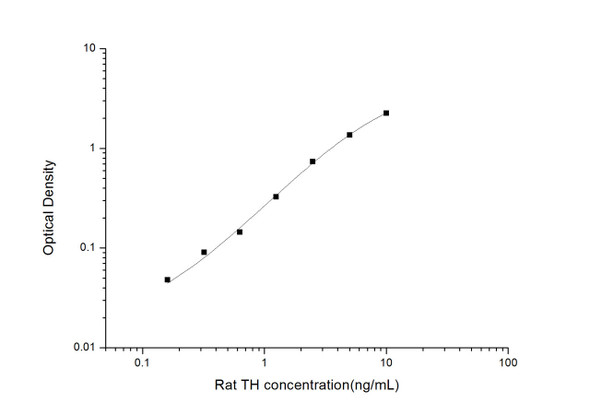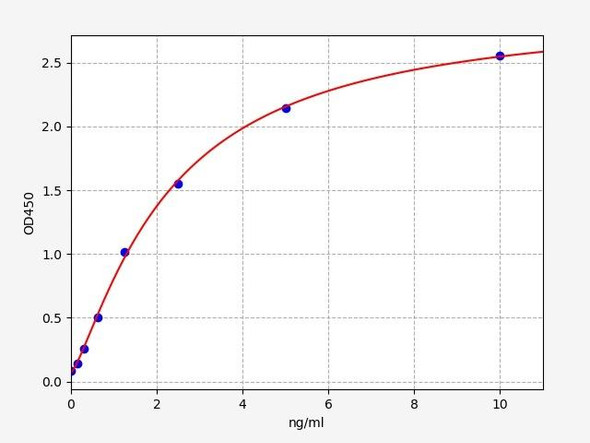Description
Mouse TH (Tyrosine Hydroxylase) ELISA Kit
The Mouse TH (Tyrosine Hydroxylase) ELISA Kit is a powerful tool for accurate quantitative determination of tyrosine hydroxylase levels in mouse serum, plasma, and tissue homogenates. This kit offers high sensitivity and specificity, ensuring precise and reproducible results for various research applications.Tyrosine hydroxylase is a key enzyme involved in the biosynthesis of neurotransmitters such as dopamine, norepinephrine, and epinephrine. Dysregulation of tyrosine hydroxylase activity has been linked to neurological disorders, psychiatric conditions, and neurodegenerative diseases, highlighting its importance as a potential biomarker for studying these disorders and developing therapeutic interventions.
With its reliable performance and ease of use, the Mouse TH (Tyrosine Hydroxylase) ELISA Kit is a valuable tool for researchers looking to investigate the role of tyrosine hydroxylase in various physiological and pathological processes in mouse models.
| Assay type: | Sandwich |
| Format: | 96T |
| Assay time: | 4.5h |
| Reactivity: | Mouse |
| Detection Method: | Colormetric |
| Detection Range: | 0.16-10 ng/mL |
| Sensitivity: | 0.10 ng/mL |
| Sample Volume Required Per Well: | 100µL |
| Sample Type: | Serum, plasma and other biological fluids |
| Specificity: | This kit recognizes Mouse TH in samples. No significant cross-reactivity or interference between Mouse TH and analogues was observed. |
This ELISA kit uses Sandwich-ELISA as the method. The micro ELISA plate provided in this kit has been pre-coated with an antibody specific to Mouse TH. Standards or samples are added to the appropriate micro ELISA plate wells and combined with the specific antibody. Then a biotinylated detection antibody specific for Mouse TH and Avidin-Horseradish Peroxidase (HRP) conjugate are added to each micro plate well successively and incubated. Free components are washed away. The substrate solution is added to each well. Only those wells that contain Mouse TH, biotinylated detection antibody and Avidin-HRP conjugate will appear blue in color. The enzyme-substrate reaction is terminated by adding Stop Solution and the color turns yellow. The optical density (OD) is measured spectrophotometrically at a wavelength of 450 nm ± 2 nm. The OD value is proportional to the concentration of Mouse TH. The concentration of Mouse TH in samples can be calculated by comparing the OD of the samples to the standard curve.
| UniProt Protein Function: | TH: an enzyme involved in the conversion of phenylalanine to dopamine. As the rate-limiting enzyme in the synthesis of catecholamines, tyrosine hydroxylase has a key role in the physiology of adrenergic neurons. Four splice variant isoforms have been described. |
| UniProt Protein Details: | Protein type:Vesicle; Amino Acid Metabolism - tyrosine; Endoplasmic reticulum; Mitochondrial; EC 1. 14. 16. 2; Oxidoreductase Cellular Component: axon; cell soma; cytoplasm; cytoplasmic vesicle; cytoplasmic vesicle membrane; cytosol; dendrite; internal side of plasma membrane; melanosome membrane; mitochondrion; neuron projection; nucleus; perikaryon; smooth endoplasmic reticulum; synaptic vesicle; terminal button Molecular Function:amino acid binding; dopamine binding; enzyme binding; ferric iron binding; ferrous iron binding; iron ion binding; metal ion binding; monooxygenase activity; oxidoreductase activity; oxidoreductase activity, acting on paired donors, with incorporation or reduction of molecular oxygen, reduced pteridine as one donor, and incorporation of one atom of oxygen; oxygen binding; protein domain specific binding; tyrosine 3-monooxygenase activity Biological Process: aromatic amino acid family metabolic process; catecholamine biosynthetic process; dopamine biosynthetic process; dopamine biosynthetic process from tyrosine; eating behavior; embryonic camera-type eye morphogenesis; epinephrine biosynthetic process; eye photoreceptor cell development; heart development; learning; locomotory behavior; mating behavior; memory; neurotransmitter biosynthetic process; norepinephrine biosynthetic process; organ morphogenesis; regulation of heart contraction; response to ethanol; response to hypoxia; synaptic transmission, dopaminergic; synaptic vesicle amine transport; visual perception |
| UniProt Code: | P24529 |
| NCBI GenInfo Identifier: | 6678337 |
| NCBI Gene ID: | 21823 |
| NCBI Accession: | NP_033403. 1 |
| UniProt Related Accession: | P24529 |
| Molecular Weight: | 55,993 Da |
| NCBI Full Name: | tyrosine 3-monooxygenase |
| NCBI Synonym Full Names: | tyrosine hydroxylase |
| NCBI Official Symbol: | Th |
| NCBI Protein Information: | tyrosine 3-monooxygenase |
| UniProt Protein Name: | Tyrosine 3-monooxygenase |
| UniProt Synonym Protein Names: | Tyrosine 3-hydroxylase; TH |
| Protein Family: | Tyrosine 3-monooxygenase |
| UniProt Gene Name: | Th |
| UniProt Entry Name: | TY3H_MOUSE |
As the OD values of the standard curve may vary according to the conditions of the actual assay performance (e. g. operator, pipetting technique, washing technique or temperature effects), the operator should establish a standard curve for each test. Typical standard curve and data is provided below for reference only.
| Concentration (ng/mL) | O.D | Average | Corrected |
| 10 | 2.259 2.317 | 2.288 | 2.218 |
| 5 | 1.506 1.558 | 1.532 | 1.462 |
| 2.5 | 0.938 0.918 | 0.928 | 0.858 |
| 1.25 | 0.447 0.473 | 0.46 | 0.39 |
| 0.63 | 0.281 0.271 | 0.276 | 0.206 |
| 0.32 | 0.183 0.157 | 0.17 | 0.1 |
| 0.16 | 0.119 0.125 | 0.122 | 0.052 |
| 0 | 0.063 0.077 | 0.07 | -- |
Precision
Intra-assay Precision (Precision within an assay): 3 samples with low, mid range and high level Mouse TH were tested 20 times on one plate, respectively.
Inter-assay Precision (Precision between assays): 3 samples with low, mid range and high level Mouse TH were tested on 3 different plates, 20 replicates in each plate.
| Intra-assay Precision | Inter-assay Precision | |||||
| Sample | 1 | 2 | 3 | 1 | 2 | 3 |
| n | 20 | 20 | 20 | 20 | 20 | 20 |
| Mean (ng/mL) | 0.47 | 1.00 | 4.38 | 0.52 | 1.03 | 4.39 |
| Standard deviation | 0.03 | 0.06 | 0.18 | 0.03 | 0.05 | 0.22 |
| C V (%) | 6.38 | 6.00 | 4.11 | 5.77 | 4.85 | 5.01 |
Recovery
The recovery of Mouse TH spiked at three different levels in samples throughout the range of the assay was evaluated in various matrices.
| Sample Type | Range (%) | Average Recovery (%) |
| Serum (n=5) | 85-100 | 92 |
| EDTA plasma (n=5) | 95-107 | 101 |
| Cell culture media (n=5) | 89-101 | 95 |
Linearity
Samples were spiked with high concentrations of Mouse TH and diluted with Reference Standard & Sample Diluent to produce samples with values within the range of the assay.
| Serum (n=5) | EDTA plasma (n=5) | Cell culture media (n=5) | ||
| 1:2 | Range (%) | 84-100 | 91-103 | 88-98 |
| Average (%) | 91 | 96 | 93 | |
| 1:4 | Range (%) | 85-99 | 83-97 | 88-101 |
| Average (%) | 92 | 90 | 93 | |
| 1:8 | Range (%) | 85-99 | 84-96 | 83-98 |
| Average (%) | 92 | 91 | 89 | |
| 1:16 | Range (%) | 86-99 | 81-91 | 82-97 |
| Average (%) | 93 | 86 | 89 |
An unopened kit can be stored at 4°C for 1 month. If the kit is not used within 1 month, store the items separately according to the following conditions once the kit is received.
| Item | Specifications | Storage |
| Micro ELISA Plate(Dismountable) | 8 wells ×12 strips | -20°C, 6 months |
| Reference Standard | 2 vials | |
| Concentrated Biotinylated Detection Ab (100×) | 1 vial, 120 µL | |
| Concentrated HRP Conjugate (100×) | 1 vial, 120 µL | -20°C(shading light), 6 months |
| Reference Standard & Sample Diluent | 1 vial, 20 mL | 4°C, 6 months |
| Biotinylated Detection Ab Diluent | 1 vial, 14 mL | |
| HRP Conjugate Diluent | 1 vial, 14 mL | |
| Concentrated Wash Buffer (25×) | 1 vial, 30 mL | |
| Substrate Reagent | 1 vial, 10 mL | 4°C(shading light) |
| Stop Solution | 1 vial, 10 mL | 4°C |
| Plate Sealer | 5 pieces | |
| Product Description | 1 copy | |
| Certificate of Analysis | 1 copy |
- Set standard, test sample and control (zero) wells on the pre-coated plate and record theirpositions. It is recommended to measure each standard and sample in duplicate. Note: addall solutions to the bottom of the plate wells while avoiding contact with the well walls. Ensuresolutions do not foam when adding to the wells.
- Aliquot 100µl of standard solutions into the standard wells.
- Add 100µl of Sample / Standard dilution buffer into the control (zero) well.
- Add 100µl of properly diluted sample (serum, plasma, tissue homogenates and otherbiological fluids) into test sample wells.
- Cover the plate with the sealer provided in the kit and incubate for 90 min at 37°C.
- Aspirate the liquid from each well, do not wash. Immediately add 100µL of BiotinylatedDetection Ab working solution to each well. Cover the plate with a plate seal and gently mix. Incubate for 1 hour at 37°C.
- Aspirate or decant the solution from the plate and add 350µL of wash buffer to each welland incubate for 1-2 minutes at room temperature. Aspirate the solution from each well andclap the plate on absorbent filter paper to dry. Repeat this process 3 times. Note: a microplatewasher can be used in this step and other wash steps.
- Add 100µL of HRP Conjugate working solution to each well. Cover with a plate seal andincubate for 30 min at 37°C.
- Aspirate or decant the solution from each well. Repeat the wash process for five times asconducted in step 7.
- Add 90µL of Substrate Reagent to each well. Cover with a new plate seal and incubate forapproximately 15 min at 37°C. Protect the plate from light. Note: the reaction time can beshortened or extended according to the actual color change, but not by more than 30min.
- Add 50 µL of Stop Solution to each well. Note: Adding the stop solution should be done inthe same order as the substrate solution.
- Determine the optical density (OD value) of each well immediately with a microplate readerset at 450 nm.









